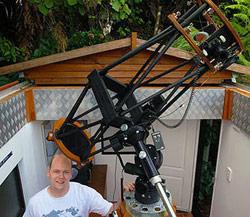Centaurus A (or Cen A to its friends) is a nearby galaxy with a weird history. It’s an elliptical galaxy—a giant cotton ball collection of stars—that was, until recently, two separate galaxies that collided and merged. It has a huge dust lane cutting right across the middle, a sure-fire sign that the galaxy was the result of a cosmic train wreck.
Amateur astronomer Rolf Olsen sent me a note the other day, telling me he had taken an image of Cen A. And it’s not just any image: It’s the result of a shocking 120 hours of total exposure! It’s a jaw-dropping view of this iconic galaxy:

Photo by Rolf Olsen, used by permission
Holy Haleakala!
The detail is amazing, and you really seriously want to embiggen it; I had to shrink it a lot to fit it on the blog. Going over the details at Olsen’s site just amazed me more and more.
[Update (June 8, 2013 at 17:00 UTC): Olsen added his image to another, wider-field image taken by astrophotographer Mike Sidonio, showing even more structure in the galaxy in the outskirts. The result is astonishing.]
First and foremost: He took these images with a 25 cm (10”) telescope that he made himself. That’s incredible. A ‘scope that small is not one you’d think you could get this kind of image with, but persistence pays off. It took a total of 43 nights across February to May of 2013 to pull this picture off.

Photo by Rolf Olsen, used by permission
The features you can see are astonishing. The galaxy has a massive central black hole, and is actively gobbling down matter (which is why it’s called an active galaxy). You can’t see the black hole itself, but blasting away from the black hole at a good fraction of the speed of light are a pair of jets, beams of matter and energy heading in opposite directions (I describe how these form in detail in a post on Herc A, another active galaxy). Olsen’s image easily captures the inner jet on the side of the galaxy facing us:
On the left is Olsen’s shot, and on the right one from a 2.2 meter telescope. Obviously, the bigger ‘scope has far higher resolution, and can see fainter stars and features in the jet, but Olsen’s shot is pretty impressive.

Photo by Peter Meecham/Rolf Olsen
In the big picture you can also see the shells of gas surrounding the galaxy, which are probably remnants of the collision, which sent out vast waves of material like ripples from a rock dropped in a pond. He was also able to identify over 700 globular clusters in his image—those are tight, spherical clusters of stars that orbit most galaxies. The Milky Way has over 150, but Cen A may have ten times as many.
Cen A is pretty close, just 12 million light years away, making it the nearest active galaxy to us, and one of the brightest in the sky. It’s best visible from the southern hemisphere, making it a juicy target for Olsen’s New Zealand location. Still, using a ten-incher to take an image this deep and detailed is a daunting task, so I encourage you to read how he did it. I’ll add that a few years back he contacted me to say he had actually seen the debris disk—the leftover planet-forming material—around the star Beta Pictoris. No amateur had ever done that (it was only discovered in the 1980s!), so I was very skeptical. But his image and methods checked out; it was an incredible acomplishment. It’s clear he is very skilled and extremely dedicated. To say the least.
I can’t even imagine what he’ll try next. But whatever it is, I know it will be worth keeping an eye on his efforts.